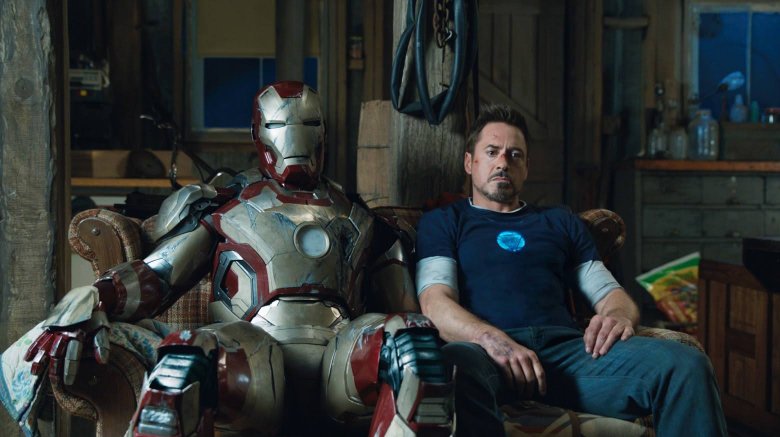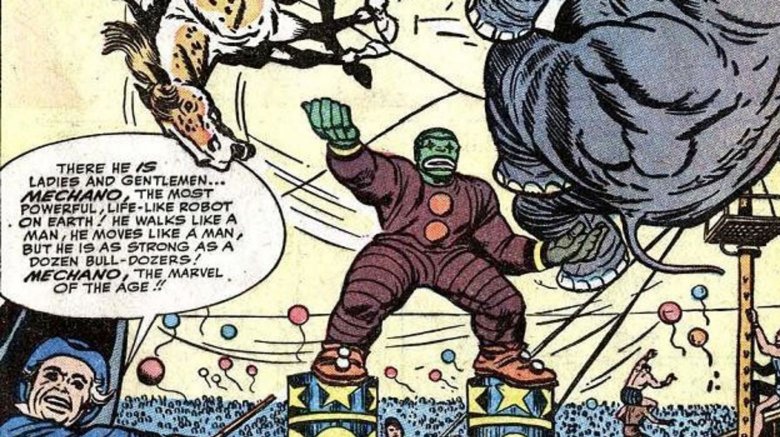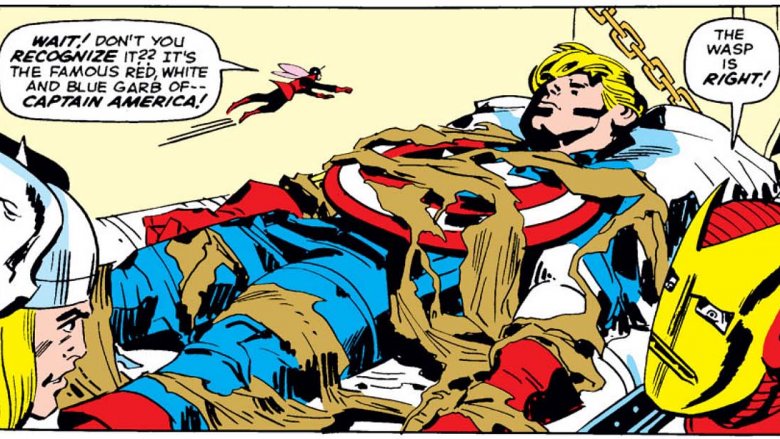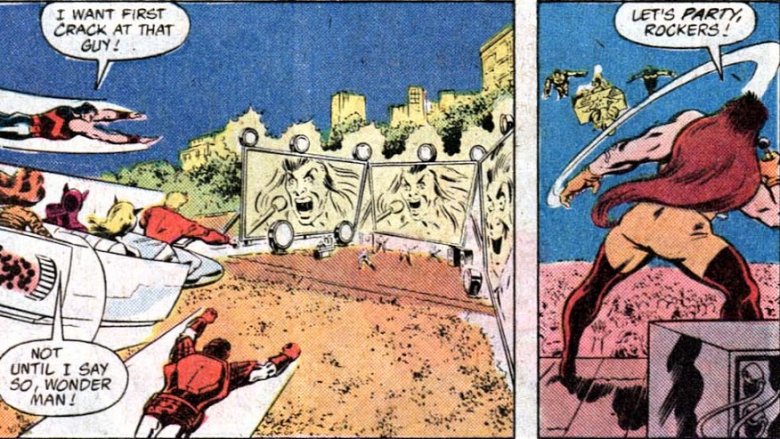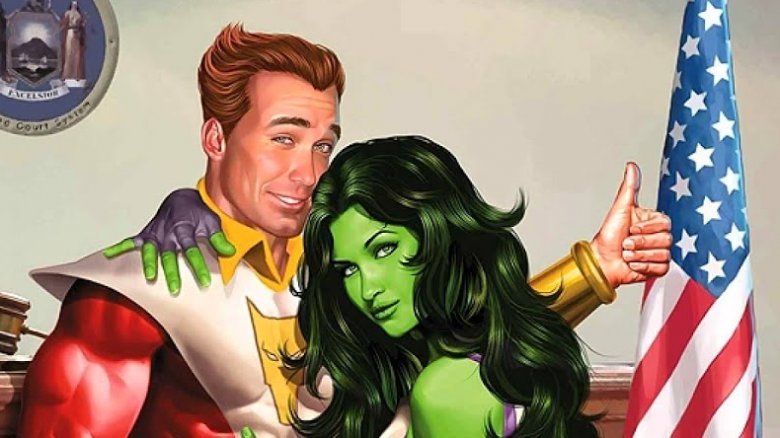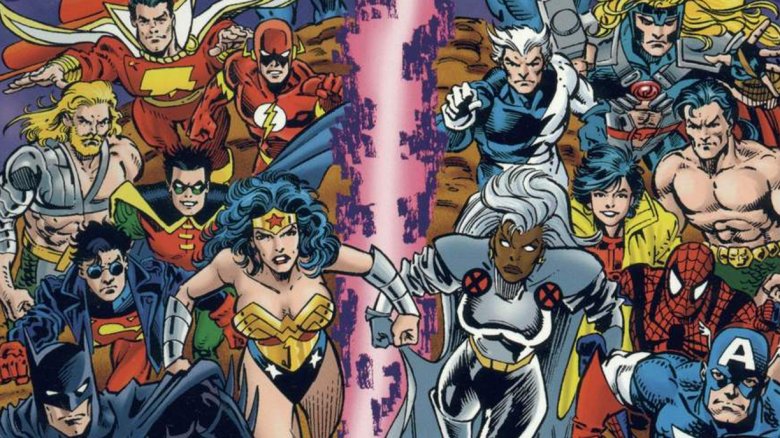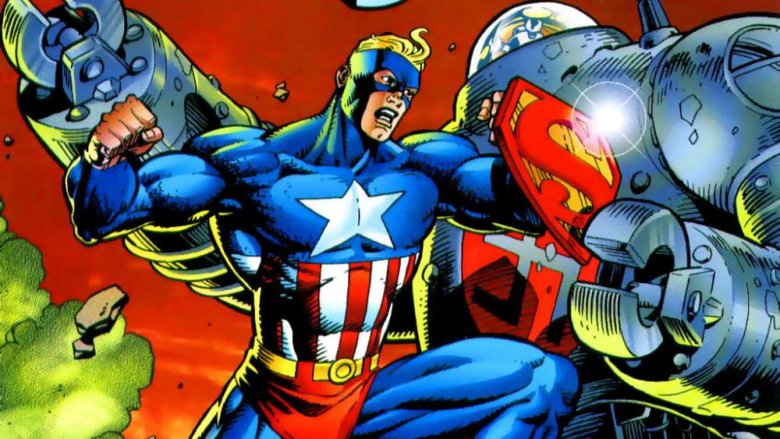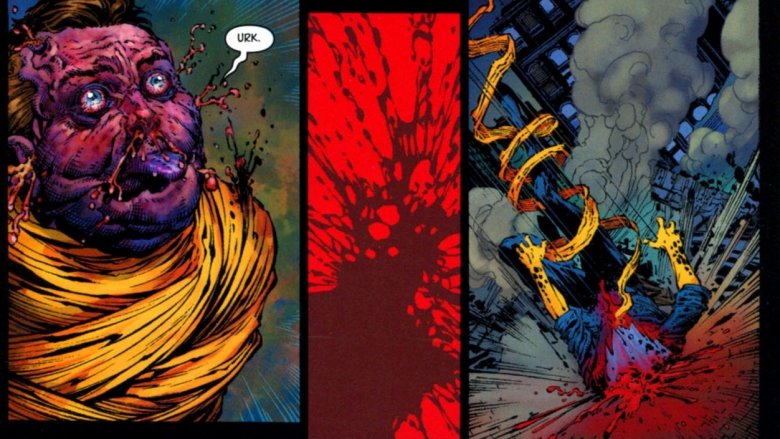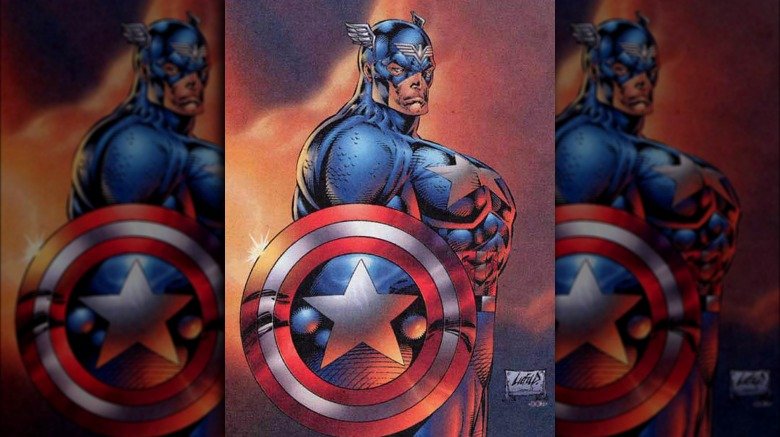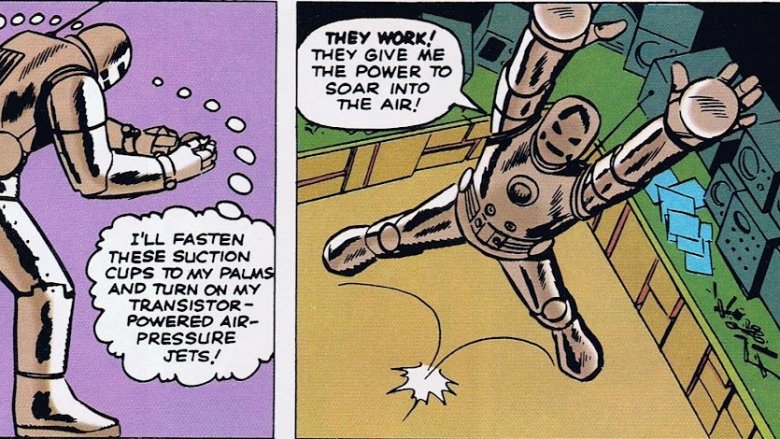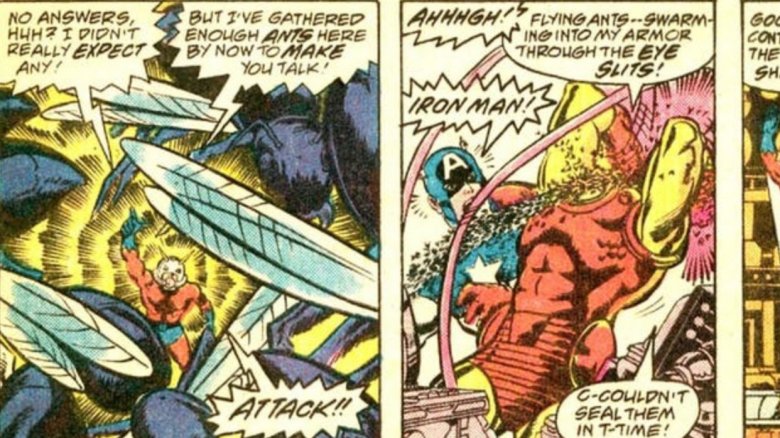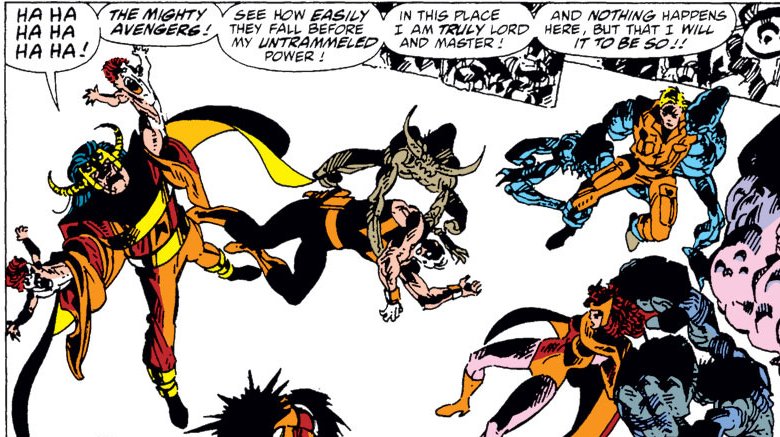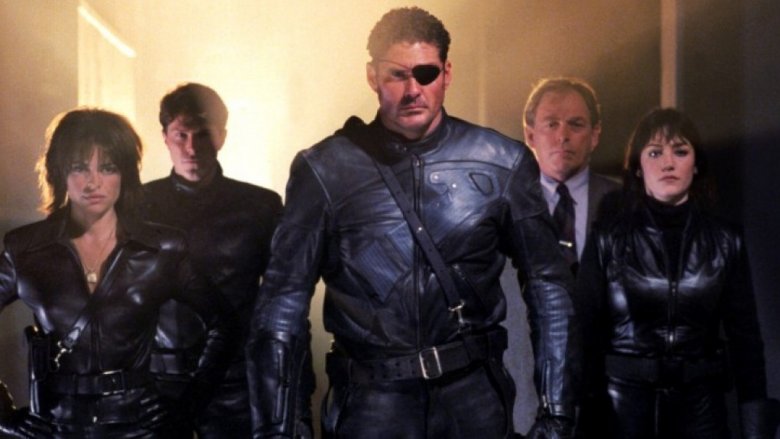What Marvel Wants You To Forget About The Avengers
The Avengers: they're Earth's Mightiest Heroes. They're our first line of defense against the universe's most dire threats. They're basically what would happen if you could sell Walter White's blue crystal in movie ticket form. For the better part of the last decade, audiences around the world have been champing at the bit for more Avengers, and the good people working the levers inside of the Walt Disney entertainment leviathan have been happy to oblige.
But the road to success is paved with enormous screw-ups, and Marvel has had more than their fair share of those. Before they became the harbinger of doom for any movies hoping to compete with them, the Avengers had a long streak of bad luck. How bad, you may well ask? Well, let's take a gander. Beware: possible spoilers ahead, if Marvel Studios ever decides to draw on seriously the dumbest stories in its history.
Gosh, Avengers #1 was just the worst
Even with the clunky Captain America costume and the shoehorned Cap/Thor/Iron Man fight scene, 2012's Avengers is still about a trillion percent better than the curry-sweats nightmare that was Avengers #1.
The team's first adventure was, golly, such prescription strength weirdness. Brought together by the chicanery of Loki, the OG Avengers consisted of Iron Man, Thor, Ant-Man, and the Wasp, banding together to take down the Hulk. A few points of interest: Tony's armor looked like a gold-plated iron lung on legs. Thor, still waffling between his personas as the God of Thunder and mild-mannered Donald Blake, keeps his identity a secret by loudly announcing what he's doing every time he transforms into the Asgardian deity. The Hulk runs from battle at one point and, pretty immediately, disguises himself as a super-strong juggling clown robot in a traveling circus. We're telling you — the story is bananas.
Then there's Ant-Man and the Wasp. Ant-Man spends a good chunk of his on-panel dialogue berating Wasp for being a woman. When he and Janet arrive at their first Avengers meeting, they stand on a projector to make themselves big enough to talk to instead of just getting all person-sized. Then they try to capture Hulk by having ants dig a hole under him, and are defeated when Hulk blows a fireplace bellows at them. Where did he get so specific a tool on such short notice? That's his secret, Cap: he always has a fireplace bellows.
How Cap got his thaw on
It might seem peculiar, what with him being the First Avenger and all, but Captain America didn't join the Avengers until four issues into their adventures. How did Steve Rogers get to the party? Buckle in, true believers, because things are about to get problematic.
Open on Thor, Ant-Man, Wasp, and Iron Man pitted against Golden Age staple the Submariner, a nautical Elrond with anger issues and the most adorable little foot wings. Submariner escapes the tussle and makes his way to the North Sea, where he finds a group of (here comes the problematic part) "uncomprehending Eskimos" worshiping a petrified figure as "mighty lord of the frozen ice." Submariner, having been gifted with the strength of a typhoon and the crabbiness of whichever sea creature is the crabbiest (maybe a crawdad or something), breaks apart the ice and sends the frozen man floating into warmer waters, where his frigid shell melts around him.
And who should that frozen man be but Captain America? And who should just so happen to be passing in their submarine but the Avengers? And how should they make Captain America prove that he's Captain America other than by having an all-out brawl with him while still inside the submarine? Ignoring the fact that they're in a pressurized tube surrounded by actual tons of water, they punch, dive, and Mjolnir-toss their way to clarity until Wasp shuts the whole thing down by standing in front of Cap and basically daring him to hit a girl.
That time they fought rock and roll
Who do you think of when you imagine the Avengers' greatest foe? Maybe Thanos, snapper of fingers and Loki necks, or Ultron and his army of tinny-but-sultry-voiced robot doubles? No, we say. Their true nemesis is the Defiler, a villain best described as "how the dad from Footloose probably imagined KISS."
The year was 1988, and frankly, it was time for superheroes to do something about all of this rock and roll malarkey. The West Coast Avengers, now within spitting distance of having their book cancelled, found themselves drawn into the path of the Defiler. While he may have appeared to be a simple skull-adorned behemoth of glam rock fronting a band called "Corruption of Innocence," he was secretly up to no good. Yes, Defiler was an interdimensional demon using the seductive power of loud music to draw in America's youth, throwing them into portal thingies and draining them of their (no kidding) "good vibrations."
Luckily for all of those easily manipulated young'uns, the only thing more powerful than the nebulously described powers of a heavily tasseled devil bad guy is (ugh) Ant-Man. He saves the day using a giant chainsaw, a giant skateboard, a giant catcher's mitt, and a giant amount of faith in the idea that readers would be into any of this. Defiler winds up knocked into one of his own portals, but this wouldn't be the last we'd hear from him — he returned in... wait, no. Never. He never returned. That was the last we heard from him.
They invited Thanos' brother onto the team
Just ask any of the children still working through the ending of Infinity War during their weekly therapy sessions: Thanos is kind of a jerk. When he's not wiping out half of all life in the universe, he's planning new ways to wipe out half of all life in the universe. That said, his family isn't all bad. Nebula and Gamora turned out, you know, imbalanced but fun. Maybe there were some other gems at the Thanos table for Thanksgiving?
Nah, not so much, but darned if that didn't stop the Avengers from recruiting the Mad Titan's brother, Eros, to the team. Better known by his superhero moniker, the ever-so-slightly-on-the-nose Starfox was a late in the game addition to Earth's Mightiest Heroes. Having the more well-meaning sibling of an unbeatable space god on your side seems like a good idea on paper, sure. Can you imagine the sheer power he probably brought to the fight?
That's another "nah." Starfox, in addition to the usual crop of super strength, flight, and so on, possesses the ability to... how do we put this delicately? Super-womanize. He stimulates the pleasure centers in other beings' brains, making them susceptible to, you know. Starfoxery. It's worth mentioning that he was on trial for sexual assault in the mid-2000s. You can just see the action figures flying off the shelf, can't you?
They fought the Justice League, and it was a bummer
In a long-ago time called the 1990s, comic book companies were in hot water. DC had burst the collector's market by reheating Superman's body 20 minutes after he croaked and Marvel was on the verge of bankruptcy. If you know comic books, you know that this is exactly the sort of "desperate times call for desperate measures" situation that leads to unlikely team-ups.
And so, DC vs. Marvel Comics was born: a four-issue series of books in which the two companies, represented by two cosmic gods with no egotistical subtext whatsoever, sent their respective champions into battle against one another to prove, you know, who was the best at punching real good.
The ensuing bundle of melees saw members of the Avengers getting slapped around something fierce by their DC opponents. Hulk took a beatdown from Superman. Captain America sort of tripped and, like all who face Gotham's Dark Knight, got hit with a Batarang and fell down. Thor did alright, managing to stop a still-called-Captain-Marvel Shazam out of the fight when he stopped his magic lightning from transforming him into his super self, but it was a victory that was dampened slightly by the fact that it was 1996 and we were still 23 years away from Zachary Levi making anyone care who Shazam was. The whole thing looked and read like a high school fan comic.
...and it continued to be a bummer
The aftermath of DC vs Marvel Comics? Those two god brothers put aside their differences and, like Hayley Mills and Hayley Mills before them, said, "Let's get together." Their cosmic bro-down created an all new comic book universe, dubbed the Amalgam Universe, and it was sort of a turd.
Amalgam was the DC/Marvel "you got chocolate on my peanut butter/you got peanut butter on my chocolate" scenario come to life. All of the two companies' greatest (read: best selling) characters saw themselves merged into half Marvel/half DC Brundlefly versions of themselves. The results were really, really hit and miss, and generally more than a little slanted in one character's direction. There was Super Soldier, the Captain America/Superman hybrid that finally answered the question "What if Superman had all of his powers and also a shield?" There was Dark Claw, a Batman/Wolverine combo that combined Wolverine's powers with Batman's Batman costume. Doctor Strange and Doctor Fate became Doctor Strangefate, and true to his progenitors, nobody really knew what the hell this guy's deal was.
In essence, the two biggest comic book publishers in the world spent a couple of years teaming up to do to their characters what Sid from Toy Story did to his dolls.
Pretty much all of Ultimatum
Around the New Millenium, Marvel launched its Ultimate banner, a modern rebooting of all of its classic characters in a parallel universe. At its best, we got things like Ultimate Spider-Man, a series with solid writing and exciting reimaginings of the heroes and villains that fans had loved for decades. At its worst, we got Ultimatum.
You know what? Pause for a second. It's not fair to call Ultimatum the worst part of the Ultimate comics line. Ultimatum was the worst part of anything at all. Ultimatum was worse than scurvy.
If you're not familiar, Ultimatum was a big fat crossover event branching from Mark Millar's perpetually gritty reboot of the Avengers, helpfully called The Ultimates since there weren't enough Ulti-words in the last two paragraphs already. It was written by Jeph Loeb, the mind behind classics like Batman: The Long Halloween and Superman For All Seasons, and it had comic fans saying, "How was this written by Jeph Loeb?"
Look, everyone loves a grim reimagining and fun is fun, but this series went off the rails. The Wasp? She gets her intestines eaten out of her torso by the Blob on panel. Hank Pym, presumably enraged that anyone besides him got to hurt his wife, bites the head off of the offending masticator. Pym later explodes, Doctor Strange's head blows up, and Thor martyrs himself up good. Also, Manhattan drowns.
They all looked like refrigerators for a while
As was mentioned earlier, the '90s were a dour time for Marvel. Sales were plummeting, storylines had become too convoluted for casual readers to keep pace, and CGI had not yet reached the pinnacle of being able to make movie stars shoot lights out of their hands convincingly. The publisher needed to shake things up a touch. They needed something fresh. They needed, probably, not to just hand their comics to Rob Liefeld again and hope it fixed everything, but hindsight is 20/20.
In late 1996, Marvel launched Heroes Reborn. Spearheaded by Jim Lee and Rob "Extreme Like a Pogs Commercial" Liefeld, it took the Avengers, along with a few other Marvel A-listers, and put them in a slightly different universe with slightly different origin stories. Coming along for the ride were exciting redesigns on the characters, and if you know Liefeld's work, you know that means DMT-fueled body dysmorphia.
Nobody walked away unscathed, but poor Cap got the worst of it. His reconstruction at the hands of late-20th century machismo-oriented body horror left us with an illustration destined for memehood.
Iron Man's long history of stupid armor
With Robert Downey Jr. rubbing charismatic excellence all over the character for over a decade, it's very possible you've forgotten that Tony Stark used to be an Olympic-level dingus. His Howard Hughes personality aside, the dude's wardrobe was a mess.
Take the Mark 1. Immortalized in 2008's Iron Man as sort of a Ned Kelly mech suit, it started life during Tales of Suspense #39 back in 1963 and it, like, wasn't great. Sure, it got the job done: it made the wearer less susceptible to getting shot a bunch and kept Tony's heart from failing, but some of its other features were objectively less super. By way of example, it let him stick to the ceiling by attaching suction cups to his hands. Because Tony Stark is a genius, that's why.
Luckily, by the Mark 2, Stark had improved on his original design significantly by, um, painting it gold. It was slow going at first. Tony's suits seemed to inadvertently follow the Adam West Batbelt tradition of doing whatever ridiculous thing needed very specifically doing. A few favorites: he spent a good long time getting around on roller skates, he built a scuba suit that shot ink like a squid, and of course, the cartoonishly-proportioned YT1 armor, affectionately known, we assume, as "The Shoulder Dislocator."
Ant-Man's long history of being terrible
Just imagine it: you've been invited to hang out at a professional level with a super soldier, a god, a billionaire, and a hulk who borders on being incredible. And you? You can talk to ants. And get small like an ant. This, friends, is the burden on Ant-Man, and while it makes his laundry list of garbage behaviors understandable, it doesn't excuse them.
Aforementioned verbal abuse and people-eating aside, Hank Pym has a long and sordid history of decidedly unheroic behavior. Back in Mark Millar's Ultimates run, an argument ended with Hank backhanding his wife, dousing her in bug spray, and setting his ants on her like the one trick pony he tends to be.
"But that was in the Ultimate universe. It's not like Hank would've ever hit Janet in regular continuity!" Wrong, you naysayer. For receipts, we point you to Avengers #213 when Pym, now on his roughly one billionth superhero identity of Yellowjacket, showed Wasp the back of his hand up close when she pointed out that he was acting crazy.
And now Scott Lang cosplays as him, without so much as a switch to a name like "Tiny-Man" or "Anti-Raid" or really anything that's a little less on-brand with domestic violence.
Master Pandemonium arms Scarlet Witch's babies
Scarlet Witch has had a doozy of a time trying to start a family. Her most well publicized misadventure into domesticity came with 2005's House of M event, in which she tried to create her own kids wholecloth by reconstructing the fabric of reality. Weirdly, though, that wasn't the most surreal example.
In the '80s, Wanda Maximoff tried to magic a pair of kids into herself, shooting for a half-her, half-Vision set of offspring. What she got ended up being some unholy and overly complex manifestation of shards of a demon soul (or something... comics were particularly hard to follow at that point). All of this pales to insignificance when compared to what happened when Master Pandemonium got his hands on them. Or rather, when he got them on his hands. Stick with us.
In the grand panoply of Marvel villains, few might make a true fan go "who?" quite the same way as Master Pandemonium. Long story short, he's a demonic antagonist with the power to turn his arms into demons... or something. The minute ol' MP got within reach of Wanda's kids, he grafted them onto the ends of his elbows and boom! Baby arms.
Yes, one of the Avengers' foes once fought the team with babies for arms. We are absolutely titillated at the prospect of what the Russo brothers are going to do with that information.
Every pre-MCU Avengers movie
With the meteoric rise of the MCU over the last decade, the casual viewer might ask themselves "why didn't anyone try to make Marvel movies sooner?" The answer: they did. They were awful.
Captain America had a pile of serials in the 1940s, and those have sort of a nostalgic charm. After that, it's tough to find an Avenger who wasn't sucking hard in movie form. There was the 1977 Spider-Man, starring a man in bondage pajamas desperately scurrying up buildings and wearing enormous web shooters on his hands. More in the mood for an onscreen Thor? Check out 1988's The Incredible Hulk Returns, the TV movie continuation of the Incredible Hulk series, with a Thor adorned in very chic furs. You've also got the backdoor pilot for a Doctor Strange series starring a young Lucille Bluth as Morgan le Fay and Peter "Who-ten?" Hooten as the good Doctor. And who could forget that David Hasselhoff played Nick Fury a mere ten years before Sam Jackson took on the role?
Add a heaping scoop of Ang Lee's Hulk and you'll understand that it's not just every single Marvel character that's searching for redemption — it's the studio itself.
